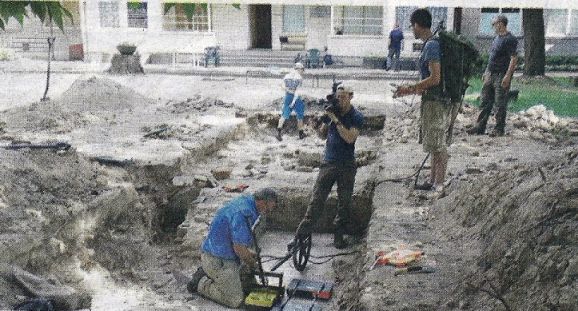
Vilna archaeological dig at the site of the Stadt Shul
After seventy-two years of lying in ruins, underground radar tests carried out last year in Vilna, the Lithuanian capital, revealed ruins of the central synagogue in the city, destroyed by the Nazi regime and buried under the ground. Now, a year after the discovery, intensive work is under way to unearth the synagogue.
In an interview with Yated Ne'eman, Dr. John Zeligman, presently living in Vilna together with researchers from the Israeli Antiquities Authority, said, "Each day that we progress in the excavation work I cannot help but getting emotional at the exposure of an illustrious past buried here in the bowels of the earth." He and his colleagues, together with a local researcher, have been toiling this past year to expose what was once a magnificent synagogue.
The central synagogue was first built in the 17th century in full splendor. Within its precinct were twelve other shuls and batei medrash, including the one of the Vilna Gaon; mikvo'os; the religious council of the Jewish community of Vilna; kosher butcher shops and the famous Strasson library. It was known as the City Synagogue — the Stadt Shul.
"We are now digging up what was the shul courtyard where we exposed the bathhouse which included a mikveh and large bathing rooms," Dr. Zeligman reported, adding, "The bath rooms are very spacious because the Jews of those times were not permitted to use the central bathhouses built for the general population and had to build their own which they constructed adjoining the mikveh in the synagogue courtyard. We found tiles adorned with animals and other various decorative depictions."
In Sivan 5701, exactly 75 years ago, during the Second World War, Vilna was captured by the German army and its soldiers plundered the entire shul compound, burning it to the ground. During the three years of German occupation, most of Vilna's Jewish population was decimated. With the entry of the Red Army to Vilna in 5704, a new school was constructed on top of the synagogue ruins.
Also, the city of Vilna is now dismantling a building that was built in part with stones taken from the Jewish cemetery. The mayor of Vilna, Ramigigus Simasius, removed the first stone from the structure, which housed a generator that provided electricity and heat to the city. This generator was built by the Lithuanian Soviet authorities between 1965-1968, when Lithuania was still under Soviet rule. The tombstones used in the structure were removed from Jewish graves on Olando Street.

Some finds from Vilna archaeological dig at the site of the Stadt Shul




